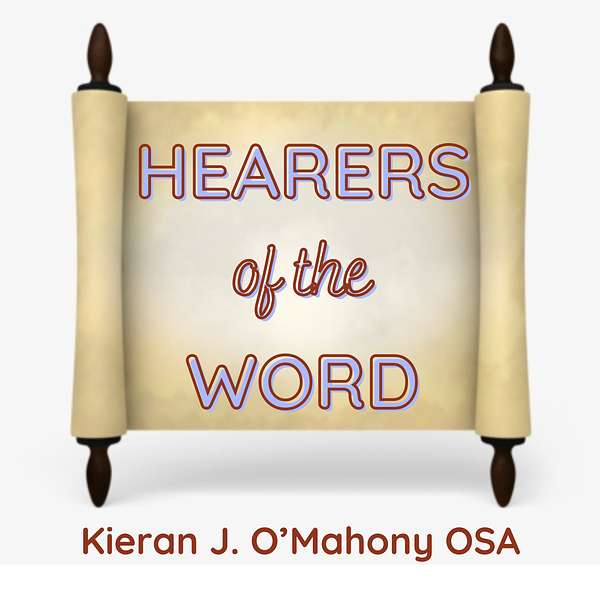
Hearers of the Word
Hearers of the Word
Learning to pray: The Lord's Prayer (Luke 11:1-13; 27 July 2025)
A reflection on prayer inspired by today's Gospel, written and spoken by Kieran J. O'Mahony OSA.
Gentle piano music to close the meditation
John’s Lane
D08 F8NW
27 July 2025
Luke 11:1-13 on Prayer
Welcome
For this podcast, I would like to reflect with you on prayer, inspired by today’s Gospel reading. Perhaps the best place to begin is to acknowledge that at the liturgy we are at prayer from the very start: the prayer of gathering in God’s presence, the prayer forgiveness and absolution, the prayer of praise in the Gloria and, in the holy readings, the prayer of listening. The liturgy continues with the Great Prayer of Thanksgiving, the Lord’s Supper, the Lord’s Prayer itself and Holy Communion. In a word, it is all prayer, a rich sequence, choreographed in different moments of gathering, praise, listening and communion.
Topic
So, what are we doing when we pray? My reflection is in three steps: prayer is a hunger of the heart, prayer is more than words, taking us into the very presence of God himself, and prayer is transformation.
Steps
Prayer is first of all a hunger of the heart. This was recognised long ago in the words of St Augustine: you have made us for yourself, O Lord, and our hearts are restless until we come to rest in you. In the case of Augustine, his journey of faith was marked by deep dissatisfaction and a longing, a hunger really, for God. His own definition of prayer reflected his experience: prayer is desire. As a definition, this is pastoral and very helpful: it means that when even we are not praying and we miss it, then in fact we are praying because the desire is there, even in absence of formal prayer.
We come to acknowledging this hunger of the heart through different, sometimes difficult, quite personal experiences. In the case of Augustine, it was actually difficult — he experienced a kind of nervous break-down. For many, it comes through nature — a good example would be the wonder triggered by the new discoveries about the universe from the James Webb Space Telescope. For others, perhaps for most, it is a quiet feeling of being drawn towards something more, with a sure sense of being held in being by the God in whom we live and move and have our being. The key is to acknowledge the desire, the hunger of the heart and to engage with it.
Perhaps you noticed in our Gospel the careful wording. The disciples do not say “Lord, teach us a prayer” but rather “Lord, teach us to pray.” As children, it is likely that we learned prayers, both traditional and modern and perhaps we tend to think that the Lord’s Prayer is a prayer like the Hail Mary. When looked at closely, however, the Lord’s Prayer is not so much a setting of words we can say but rather a series to steps we can undertake when we pray. We start with God, move to our everyday needs and close with the link between prayer and life. The Lord’s Prayer is more than a formula of prayer: it is really a way of praying.
As time goes on, we can experience a need to grow more deeply as people of prayer. This might manifest itself again as dissatisfaction, this time with saying prayers. It can come indirectly through yoga or meditation for well-being. However it comes, it is vital that we engage with this desire for something more. The next level of prayer is often given different names: silent prayer, prayer of quiet, the prayer of presence, Christian meditation, even contemplation. Very simply, God is always present to us; in Christian meditation we are present to God, holding ourselves before and within the mystery. One of my favourite lines from St Paul is Romans 5:5: the love of God has been poured into our hearts through the Holy Spirit given to us. That gift is the very foundation of Christian meditation.
In the teaching on prayer of the Benedictine John Main, for example, it is recommended to do 20 or 25 minutes twice a day, sustained by a prayer-word. The practice of such quiet prayer, while simple, is demanding to sustain. It calls for commitment and steadfastness; it will involve “unlearning,” that is, the gradual setting aside of my agenda or my wishes or even my thoughts. Because it is austere, it needs to be supplemented by praying with scripture — simply to be nourished and sustained, to be loved by God, to seek his wisdom in our lives and for the decisions we have to make. Practiced consistently, the prayer of presence is ultimately life-changing and transformative.
Conclusion
In our time, there is a growing and world-wide interest in Christian meditation. A good example is the continuing work of the same John Main, which is continued today by the World Community for Christian Meditation. This Benedictine inspiration is also present in Ireland and they have their own website: www.WCCM.org. The website is very helpful and rich in resources.